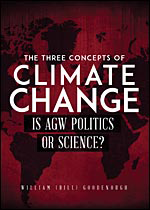A shift in Earth’s magnetic poles may hold the secret to climate change
As scientists study the causes and severity of climate change, they have looked to Earth’s atmosphere for answers.
But that may be the wrong place to find a satisfying and correct solution, says William Goodenough, author of “The Three Concepts of Climate Change: Is AGW Politics or Science?”
Instead, the key to unlocking the global-warming riddle could lie in the planet’s magnetic poles, which have been shifting from their traditional locations at the same time that the Earth has experienced erratic, unpredictable behavior with the weather, he says.
“It seems very likely that a magnetic-pole shift event is causing the unstable weather conditions we are experiencing today, and could cause sustained changes to the Earth’s climate conditions,” Goodenough says.
If true, that would mean that climate change is being driven by natural forces, and not by humans spewing CO2 into the atmosphere, as many scientists and politicians claim, Goodenough adds.
According to NASA, NOAA, and the ESA the magnetic North Pole has been creeping northward from Canada toward Russia – by more than 1,000 miles – since the early 19th century, when explorers first located it precisely.
“It is moving faster now, actually, as scientists estimate the pole is migrating northward about 40 miles per year, as opposed to about 10 miles per year in the early 20th century,” NASA reported in 2012.
NASA also says that is nothing new. Throughout Earth’s 4.5-billion-year existence, the space agency says, the two magnetic poles have swapped positions about every 500,000 years or so; however, poles shifts have not been identified or studied.
Although the scientific community doesn’t link the shift to climate change due to its interdisciplinary nature, Goodenough says the connection is worth exploring and is demonstrable.
“Climate science is a murky science,” Goodenough states. “When dealing with temperature variations and trends that might be influenced by humans, we do not have an instrument that tells us how much change is due to humans and how much to Mother Nature.”
Goodenough’s background is as a technical analyst, not a climatologist, but it was while he was involved in his line of work – analyzing aerospace GPS capabilities – that he began to form his thesis.
Fascinated by the fact that Earth’s magnetic poles were relocating, he began a 12-year study that resulted in his analytical abilities converging with the climate-change arena, where political debates have gotten as much attention as scientific research.
The Earth has two magnetic sources of energy. The first is the Earth’s dynamo system that provides Earth’s shield and is expressed at the geophysical North and South Poles. The second is a magnetic bond between the Earth and the sun and is expressed as the North and South Magnetic Poles.
Goodenough says magnetic pole relocation affects Earth in two ways:
• It alters the direction of the enormous current flow through the Earth, theoretically causing magnetic chaos in the Earth’s core, which in turn weakens the Earth’s magnetic shield that protects the planet from damaging solar particles.
• It changes the direction of the interaction between the geophysical and the magnetic North Poles by moving the coldest area of the Arctic, thereby altering the climate. Each set of poles (North and South) interact to determine the temperature profile relative to their respective pole. “The altered pole temperature profiles cause significant climate change,” Goodenough says. “We are currently witnessing an unstable and changing climate. We are not experiencing abnormal total Earth temperature changes.”
Although Goodenough is convinced that the shift of the magnetic poles is the true cause of climate change this thesis needs more study, and he says there are several interested parties that would benefit from such research.
“The fossil fuel industry is one example,” he says. “If we can show it’s a certainty that global warming is from this natural shift and not CO2, then fossil fuels wouldn’t have the bad name they do right now in all this.
“The reason there’s so much contention about global warming is pretty simple to understand. In climate-change science we basically cannot prove anything about how the climate will change as a result of adding extra greenhouse gases to the atmosphere. So we are left to argue about claims that can’t be proven. That’s what it boils down to.”
William Goodenough, author of “The Three Concepts of Climate Change: Is AGW Politics or Science” (www.whyclimatechange.net), is a technical analyst with decades of experience in scientific analysis of computer systems, control systems, pneumatic systems, power distributions systems, automated processes, hydraulic systems and fuel systems related to aerospace certification. His career has encompassed extensive travel within the United States and in South American, Japan and Korea. He holds a bachelor’s degree in electrical engineering.





